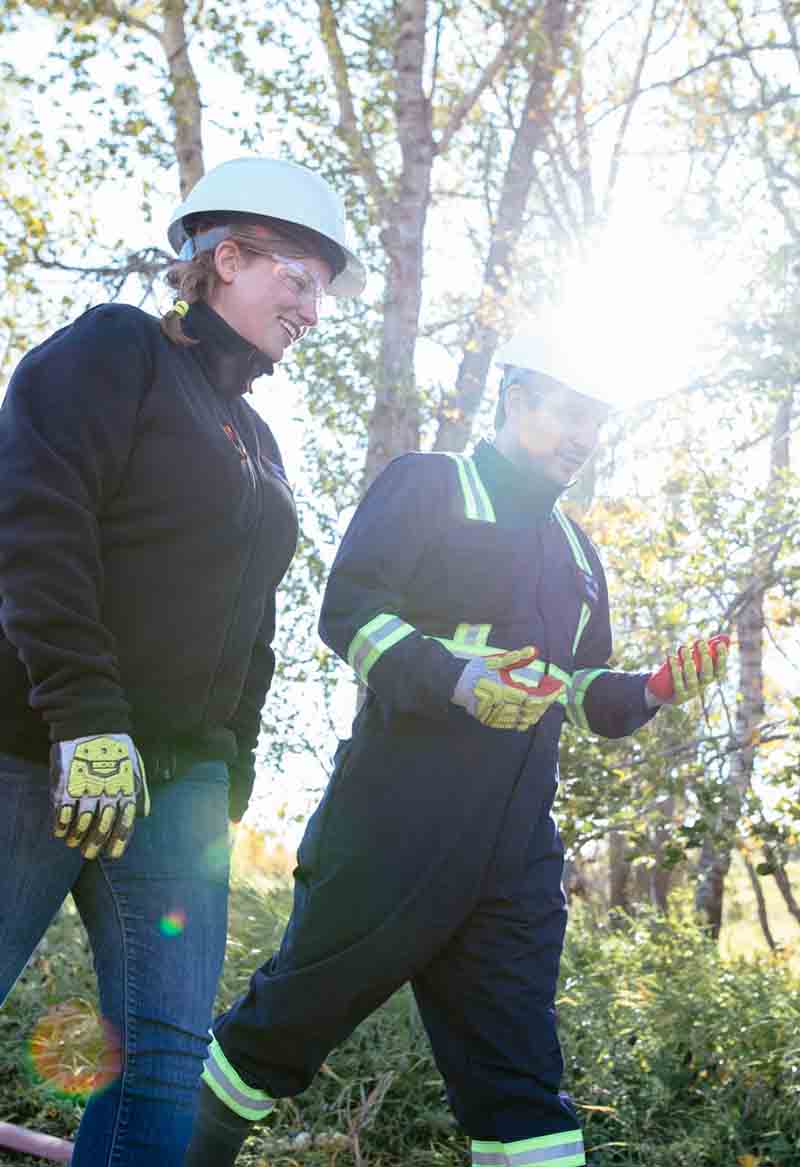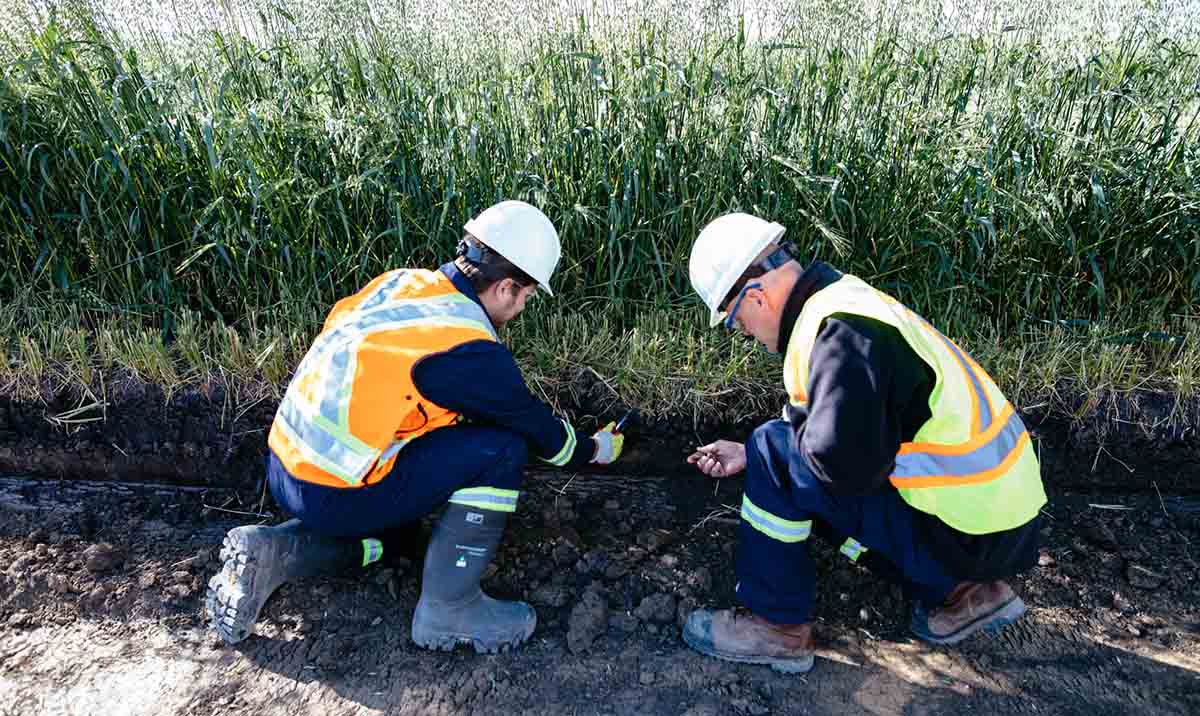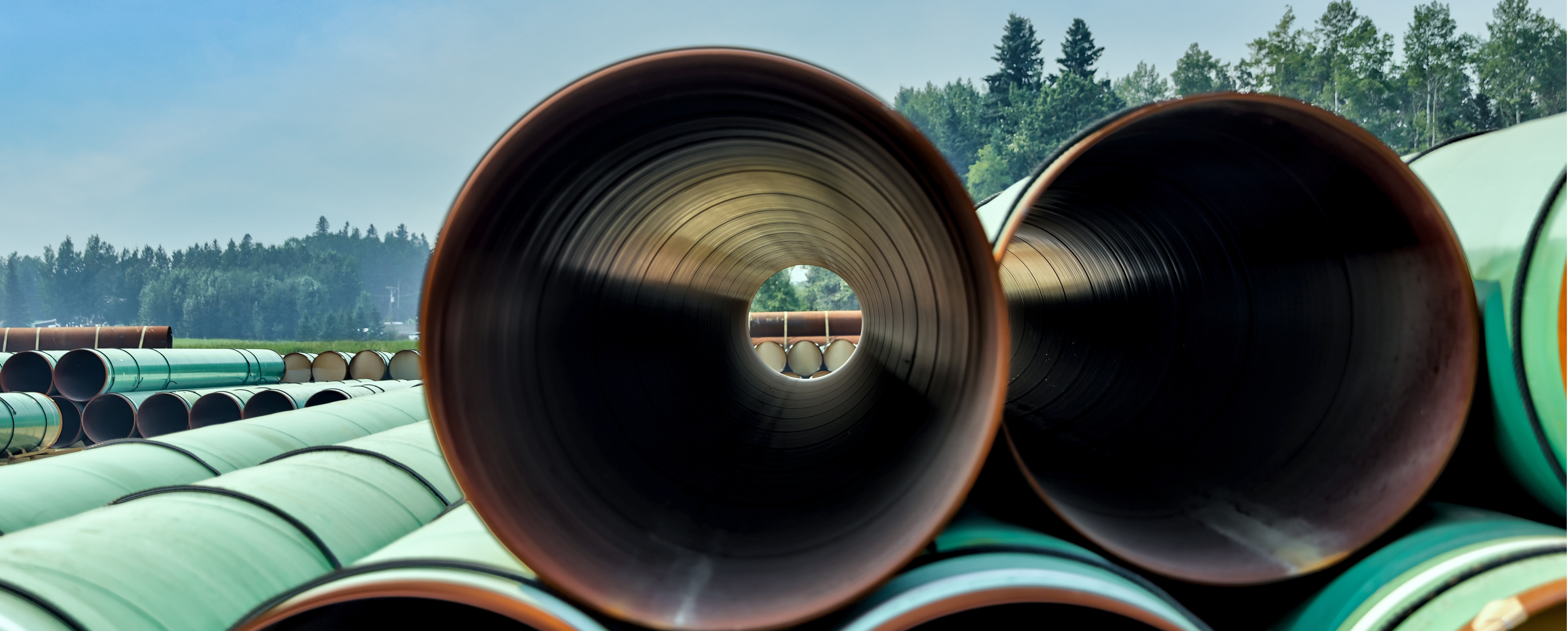2023–24 Annual Report of the Canada Energy Regulator – Core Responsibilities: The CER’s Achievements in 2023–24

Safety and Environment Oversight
The CER works for Canadians to keep energy moving safely and efficiently through the country’s pipelines and powerlines. The organization performs this function by setting and enforcing regulatory expectations for companies over the entire lifecycle of federally regulated energy infrastructure - construction, operation, and abandonment.
The CER enforces some of the strictest safety and environmental standards in the world, and its oversight goes beyond simple compliance. The organization promotes best practices to reduce the potential for harm, adopting new technologies and innovative approaches to improve the effectiveness and efficiency of a company’s management system to prevent harm.
Regulated companies must have emergency management programs, including a robust continuing education program for the police, fire departments, medical facilities, other agencies, and people who live or work near the pipeline. The CER also expects companies to engage with all people living and working near pipelines, including Indigenous Peoples, the public, contractors, landowners, and municipalities, to promote safe work practices and actions they can take to prevent damage to pipelines.
The CER’s Commitment
- Harm to people and the environment, through the lifecycle of energy-related infrastructure, is prevented.

Performance Results Summary 2023-24 – Safety and Environment Oversight
Performance Measure |
Target |
Results |
Results |
Results |
|---|---|---|---|---|
Number of serious injuries and fatalities related to regulated infrastructure. |
0 |
213 |
93 |
|
Number of incidents related to regulated infrastructure that harm the environment. |
0 |
203 |
283 |
263 |
Percentage of unauthorized activities on regulated infrastructure that involve repeat violators. |
<15% |
10% |
16% |
11% |
Compliance Verification Activities
The CER aims to achieve zero incidents, meaning there is no harm to people or the environment on the energy infrastructure it regulates. The CER follows a risk-based approach in planning and conducting Compliance Verification Activities (CVAs). When the activities of regulated companies have the potential to pose greater harm to people or the environment, the CER increases oversight through engagement, inspections, investigations, audits, and enforcement, when necessary.
In 2023–24, the CER conducted 204 CVAs, which included:
104
Inspections
20
Emergency Response
Exercises
6
Management System
Audit Reports
68
Compliance Screening
Meetings
6
Manual Reviews

In addition to CVAs, the CER provides oversight in other ways, such as:
- analyses of the root causes of incidents to ensure appropriate corrective actions or to identify preventive actions;
- examination of conditions of authorizations (e.g. orders and certificates) to verify that companies are taking the necessary steps to comply with these conditions;
- responses to emergencies when they happen to verify that companies are protecting the safety of people and minimizing and remediating any environmental damage;
- reviews of Operations and Maintenance notifications as part of ongoing oversight of operating facilities; and
- reviews of contaminated sites documentation to oversee companies' management of contamination and remediation activities.
In 2023–24:
- 487 conditions were closed.
- 527 new project specific conditions were issued.
- 1161 post-approval documents were filed with the CER.
- 534 Operations and Maintenance notifications were reviewed as part of ongoing oversight of operating facilities.

Construction Oversight of the Trans Mountain Expansion Project
In 2023–24, construction activities on the Trans Mountain Expansion Project (TMEP) continued across all areas of the Project. The CER continues to hold the company accountable for fulfilling project conditions and for meeting its regulatory obligations and commitments, including as it transitions to the operational phase in 2024–25.
The CER completed 51 CVAs on TMEP in 2023–24, including inspections, emergency response exercises, and compliance meetings. Indigenous Monitors from the Trans Mountain Expansion - Indigenous Advisory and Monitoring Committee participated in 41 CVAs with CER staff. Review of project condition compliance filings continued throughout the year, and consideration of various relief requests, primarily related to the timing of compliance submissions, but also to variance applications and route deviations.
During 2023–24, the company received 18 Leave to Open authorizations from the CER, resulting in the company being able to begin operating portions of the Project such as pump stations and expanded terminals. The Leave to Open process is the final determination by the CER that the pipeline or facilities are safe to use and to begin to transport crude oil.
The company was required to report serious injuries that occurred during construction, near-miss events, and incidents that harmed the environment. Trans Mountain reported five serious injuries in 2023–24, a 69 percent reduction from the previous year. Over half of the injuries reported in 2023–24 involved contact with equipment or materials. The CER followed up on all serious injuries to ensure the company identified causes, corrective actions and preventative actions. Environmental incidents this year were largely construction related, primarily within the themes of sedimentation events, inadvertent fluid releases, and physical alterations related to construction resulting in impacts to watercourses and fish.
CER Inspection Officers issued five Orders to Trans Mountain during 2023–24 in cases where non- compliances related to Safety, Environmental Protection, or Socio-Economic matters warranted enforcement action.
See Appendix F for more information on Inspection Officer Orders issued in 2023–24.
Remediation Oversight
Remediation oversight activities in 2023–24 focused on expanding the efficiency of oversight of the 475 active contaminated sites under CER jurisdiction. Staff conducted 10 CVAs (meetings and field inspections) focused on contaminated sites themes, reviewed 460 annual updates and completed review of 28 Remedial Action Plans, Risk Management Plans and Closure Reports.
As part of the continual evolution of the Remediation Process, the CER published a bulletin that clarifies its expectations for contents of Remediation Closure Reports called a closure checklist.
Indigenous Monitoring
The CER is committed to advancing Reconciliation with Indigenous Peoples and finding new ways to include Indigenous Peoples in the oversight of federally regulated infrastructure, as it builds trust and confidence while strengthening environment and safety oversight. The CER continues to increase the involvement of Indigenous Monitors through several aspects of its compliance verification activities.
“Working alongside Indigenous Monitors is one of the most rewarding parts of my job as an Inspection Officer. Whether participating in collaborative events and learning about Indigenous culture or working together in the field during compliance verification activities in environmental protection, the experiences always broaden my perspectives. An inspection from this year that has stuck with me is when our joint CER Inspection Officer and Indigenous Monitor team identified an inappropriately mitigated and active red-tailed hawk nest adjacent to a project construction site. Together, we confirmed the company’s non-compliance and took the necessary steps to make sure the nest remained safe. That’s truly purposeful teamwork in environmental protection, and I would like to think the hawks appreciated it too!”
CER Inspection Officer Jeremy Demytruk
Security
The CER’s Security team conducted 16 CVAs in 2023–24, seven of which focused on cyber security. The CER launched a new cyber security CVA process focused on the cyber security measures that regulated companies have implemented on their operational technology system. Significant work was undertaken to mature the cyber security CVA process, including strengthening the CER’s relationships with stakeholders to better understand the cyber security threats regulated companies are facing, participating in formalized cyber security training, and soliciting feedback from partners on how to continue to mature the CER’s cyber security oversight of regulated companies.
Emergency Management
The Emergency Management Program conducted 41 CVAs in 2023–24. This included 12 compliance meetings, 20 exercise evaluations, 3 inspections, and 6 emergency procedures manual reviews. Identified trends in emergency response inform updates to internal emergency management work instructions and processes, helping the CER to prepare for and operate effectively during an emergency and to continually improve response readiness.
An Information Advisory regarding emergency preparedness and response at liquid storage facilities was issued in January 2024. The advisory applies specifically to the processes for hazard identification and analysis, and for the evaluation of risks essential to the development and implementation of controls. This includes pre-fire planning and determining resource requirements for responding to fire incidents that could occur at liquid storage tank facilities. Information advisories are shared directly with regulated companies and published on the CER’s website.
Audits and Enforcement
Management System Audits
The CER’s operational audits evaluate how a company manages its activities. The CER requires all regulated companies to have effective management systems and protection programs.
In 2023–24, the CER conducted six operational audits: three addressing control room management and three covering damage prevention.
The CER publishes management system audit reports and related documents on its Compliance and Enforcement webpage.
Further information on Audits is found in Appendix E.
Administrative Monetary Penalties
Administrative Monetary Penalties (AMPs) provide the CER with a flexible enforcement tool to promote compliance with legislation, regulations, decisions, permits, orders, licenses or certificate conditions.
The CER issued one AMP in 2023–24.
Further information is found in Appendix G. The CER also publishes all of its AMPs and related documents on its Compliance and Enforcement webpage.
Safety Culture
The CER has committed to building an improved understanding of safety culture across the pipeline industry. In 2023-24, the CER developed and implemented its latest three-year Safety Culture strategy and workplan. Efforts through 2026 will continue to focus on two goals:
- System-wide influence - The CER will take a system-wide approach to influencing a positive safety culture across industry that supports effective management of threats to people and the environment.
- Company performance - The CER will enhance company understanding and detection of underlying human and organizational factors to support improved risk management and safety culture maturity.
This year, the CER developed and published Human and Organizational Performance guidance and tools for use by industry with work underway to launch complementary interactive e-learning modules (CER Safety Culture Learning Portal). The CER also facilitated industry-wide learning through annual workshops with regulated companies, including two sessions designed specifically for Chief Executive Officers and executive leaders. This year, the CER continued its outreach activities, including leadership and participation in the North American Regulators Working Group on Safety Culture.
Regulatory Framework Program
The Regulatory Framework Program delivers the CER’s regulatory policy functions and is dedicated to implementing a Regulatory Framework that is robust, clear, transparent, coherent and consistent. To achieve this goal, the CER works with a broad range of stakeholders to continually improve regulatory tools; ensuring regulations that are in force remain appropriate and regulatory documents, policies and guidance achieve their intended purpose.
Further information on Regulatory Framework Projects is found in Appendix D.
Abandonment Cost Estimates and Set Aside and Collection Mechanism Review
As part of the CER’s financial compliance program, the second five-year review of Abandonment Cost Estimates (ACE) and first Set Aside and Collection Mechanism review was initiated in 2021. In Part 1 of the review, the Commission applied a new CER-developed method based on Geographic Information Systems to calculate Base Case 2021 ACEs for each company. On 15 June 2023, at the conclusion of Part 1 of the review, the Commission issued its report and each company’s Base Case 2021 ACE. On 27 March 2024, the Commission released its reasons and approved new ACEs for companies with CER-regulated pipeline systems.Footnote 4 The Commission provided higher, future-proofed dollar values for company ACEs for companies holding letters of credit or surety bonds.
Energy Adjudication
The CER’s mandate includes making decisions and providing recommendations to the Minister on applications and environmental assessments through predictable and timely processes. These applications relate to pipelines and connected facilities, international power lines, tolls and tariffs, energy exports, oil and gas exploration and drilling in certain northern and offshore areas of Canada, and future offshore renewable energy projects. Decisions and recommendations use fair and inclusive processes, supported by the CER’s provision of participant funding, land matters complaint resolution services, and supporting Crown consultation. When a project has reached the end of its useful life, the CER reviews abandonment applications to ensure that companies abandon the energy projects in a safe and environmentally responsible manner.
The Commission’s responsibilities include decisions on tolls and tariff applications and applications for pipelines under 40 kilometres (km). Applications for pipelines over 40 km require Governor in Council (GIC) approval based on a Commission recommendation. Any project that proposes more than 75 km of new right-of-way requires an integrated review process led by the Impact Assessment Agency of Canada.
While the Commission carries out its responsibilities independently, it is part of the CER and contributes to the overall delivery of the CER mandate. The CER Act outlines how the Commission assesses applications. The legislation focuses on early engagement, and inclusive and meaningful participation, particularly with Indigenous Peoples, in project assessments and includes the mandatory consideration of Indigenous knowledge and a project’s potential impacts on the rights of Indigenous Peoples.
For further details on adjudicative decisions and recommendations submitted to the Minister, please see the 2023-24 Annual Report of the Commission of the Canada Energy Regulator.
The CER’s Commitment
Energy adjudication processes are fair, timely, transparent, and accessible.
Performance Results Summary 2023–24 – Energy Adjudication
Performance Measure |
Target |
Results |
Results |
Results |
|---|---|---|---|---|
Percentage of adjudication decisions overturned on judicial appeal related to procedural fairness. |
0% |
0% |
0% |
0% |
Percentage of adjudication decisions and recommendations that are made within legislated time limits and service standards. |
100% |
83% |
100% |
100% |
Percentage of surveyed participants who indicate that adjudication processes are transparent. |
75% |
89% |
83% |
85% |
Percentage of surveyed participant funding recipients who agree that participant funding enabled their participation in an adjudication process. |
90% |
94% |
94% |
95% |
Infrastructure Applications
This past fiscal year, the Commission adjudicated 48 infrastructure applications. This included one large infrastructure application – NorthRiver Midstream’s NEBC Connector Project. The Commission recommended that the project be approved, subject to 49 conditions. The Commission also held hearings for Trans Mountain’s applications for a route deviation in the Pípsell (Jacko Lake) area, and for a change in the size and thickness of a 2.3 km segment of pipeline in the Fraser Valley. The Commission also adjudicated on 11 small infrastructure applications, and 19 Onshore Pipeline Regulations applications (i.e., Reactivation, Deactivation, Decommissioning). All infrastructure applications met service standards and legislated time limits. For a complete breakdown of Commission decisions and recommendations, please see the 2023-24 Annual Report of the Commission of the Canada Energy Regulator.
Tolls and Tariffs Applications
The Commission adjudicated several tolls and tariffs applications in 2023-24, including an application from Trans-Northern Pipelines Inc. for a new Incentive Tolls Settlement Agreement, and an application from NOVA Gas Transmission Ltd to affirm the toll methodology applicable to the North Montney Mainline. The Commission also ruled on several toll settlement applications, including approving Enbridge's application for the Mainline Tolling Settlement which determined the calculation of tolls for shippers to move their products on the pipeline through December 2028. Through its toll and tariff process improvement initiative, the Commission finalized several processes, procedures, and templates - resulting in more consistent processes for efficient and transparent adjudication based on best practices. The Commission continues to be occupied with several toll applications, including an application from Trans Mountain to set interim tolls on the Trans Mountain system, post-expansion.
Exploration and Production Applications
This past fiscal year, the Commission adjudicated 38 applications related to exploration and production. Among these decisions were the first approvals issued under the Northwest Territories’ Oil and Gas Operations Act and regulations since the CER's establishment in 2019. A total of five authorizations under this act were provided in relation to the Inuvialuit Energy Security Project Ltd.’s development project in the Inuvialuit Settlement Region.
Crown Consultation
The CER’s approach to Crown consultation occurs primarily through the Commission’s adjudication processes. Indigenous Peoples are encouraged to participate for their views to be heard directly by the Commission. For project applications where the Governor in Council is the final decision-maker, the CER (in its capacity as Crown Consultation Coordinator) conducts supplemental Crown consultation activities with Indigenous communities before, during, and after the Commission’s assessment process. Crown consultation reports are prepared, including recommendations on how to avoid or mitigate the project’s impacts on the rights of Indigenous Peoples, and submitted to the Commission for consideration during the hearing. This helps inform the Commission’s assessment of a project, including a project’s impacts to rights and any accommodation measures, including conditions. The CER also consults Indigenous communities on the Commission’s Recommendation Report to understand if there are any outstanding impacts to rights and whether further accommodation is needed. This helps inform the GIC's decision on the project application.
Throughout 2023, the CER conducted supplemental Crown consultation activities for NorthRiver Midstream’s application for the NEBC Connector Project. Crown consultation highlights include:
For the first time since 2015, the GIC decision on a major infrastructure application with supplemental Crown consultation was completed on time, without any extensions to legislative timelines. The GIC approved the project and determined that the duty to consult was adequately met and there were no legal challenges to the GIC’s decision.
The Crown Consultation Coordinator held a total of 71 consultation meetings with Indigenous communities and filed eight substantive consultation submissions during the Commission’s hearing process, including 11 recommendations to the Commission for its consideration based on what the CER, in its role as Crown Consultation Coordinator, heard from Indigenous communities.
The CER initiated supplemental Crown consultation activities for Pouce Coup Pipe Line Ltd.’s Taylor to Gordondale Project in December 2023 and for Westcoast Energy Inc.’s Sunrise Expansion Program in January 2024. These early Crown consultation activities will help identify areas of concern, as well as opportunities, for Indigenous communities and ways in which the Commission’s hearing process can deepen Indigenous communities’ involvement and input.
Dispute Resolution
The Dispute Resolution Process plays a vital role in how the CER fulfills its mandate to help balance the interests of all Canadians in the stewardship of pipelines and energy development in Canada. Dispute resolution refers to the processes and methods (i.e., the Complaint Resolution Process and Alternative Dispute Resolution Process) used to resolve disputes between companies and rights holders, owners and users of lands, Indigenous Peoples, other orders of government, and nongovernmental organizations. By participating in Dispute Resolution Processes, parties can directly address their specific concerns about the CER’s regulated facilities.
Disputes pertain to CER regulated facilities and activities, such as pipeline maintenance and pipeline application hearings. Most of these issues are related to compensation, access to land, damage to property, crossings, construction noise, notification, applications, and detailed route hearings.
Dispute Resolution: Highlights from 2023-24
30 disputes received, 100% of which the CER responded to within the ten-calendar day service standard.
21 disputes resolved, 100% of which were resolved within the service standards. Of those resolved, 17 were resolved using Alternative Dispute Resolution processes outside of the formal regulatory process.

Early Engagement with the Public
In March 2024, the CER undertook early engagement activities with the general public related to Pouce Coupé Pipe Line Ltd.’s Taylor to Gordondale Project and Westcoast Energy Inc.’s Sunrise Expansion Program. The CER’s early engagement activities focus on educating the public on the CER’s role as a regulator and providing information on the proposed projects and how to participate in the upcoming hearings, including participant funding.
Orphan Pipelines
The CER’s Designated Officer issued two orders in 2023-24, designating two pipelines as “orphan pipelines,” bringing the CER’s total number of orphan pipelines to three. Terra Energy’s Ladyfern Gas Pipeline, an approximately 5.5 km natural gas pipeline located in northeastern British Columbia, and Glencoe Resources’ North Reagan Pipeline, a 215 metre crude oil pipeline located in Alberta, were designated in June and July 2023Footnote 5, respectively. The CER is now working to determine the necessary abandonment works that are required to maintain and improve upon the ongoing protection of the public and environment.
Applications Dashboard
In 2023-24, the CER expanded the use of the external facing Applications Dashboard tool, moving from the pilot phase to a wide deployment. Application Dashboards were launched for all small infrastructure applications and any application associated with a hearing process that was filed this fiscal year. In total, 20 dashboards were created. The Application Dashboard is a tool that improves access to reliable data and information which allows more informed decision-making, better process transparency and efficiency, and more meaningful engagement for all participants.
Energy Information
The CER collects, monitors, analyzes, and publishes information on energy markets and supply, energy sources, and the safety and security of pipelines and international power lines. The CER plays a vital role in conveying timely and relevant information to Canadians and is at the forefront of energy markets monitoring and analysis. Staff model Canada’s energy supply and demand projections, provide Canadians with reports and analysis to help inform daily choices on energy matters and support regulatory hearings on pipeline projects in Canada. The CER also collaborates with the Canadian Centre for Energy Information (CCEI) on a variety of energy data and information initiatives that are prioritized in the CCEI's annual workplan.
The CER’s Commitment
Canadians can access and use energy information for knowledge, research, or decision-making.
Canadians have opportunities to collaborate and provide feedback on CER information products.
Performance Results Summary 2023–24 – Energy Information
PERFORMANCE MEASURE |
TARGET |
RESULTS |
RESULTS |
RESULTS |
|---|---|---|---|---|
Evidence that Canadians access and use CER Energy Information products and specialized expertise, including community-specific information, for knowledge, research, or decision-making. |
Narrative* |
Target achieved* |
Target achieved* |
Target achieved* |
Number of opportunities that Canadians have to collaborate and provide feedback on energy information products. |
85 |
85 |
166 |
231 |
The CER’s Energy Information products in 2023-24:
- 24 new online energy information products
- 21 Market Snapshots; including 11 on crude oil or natural gas, 7 on renewable energy, and 3 regarding electricity
- More than 1.6M energy and pipeline information web page views
- 230 information request responses
- 231 collaborative engagements with energy stakeholders
- 174 citations of energy and pipeline information sourced as a reference in major online publications
Canada’s Energy Future series
In June 2023, the CER released its flagship publication, Canada's Energy Future 2023: Energy Supply and Demand Projections to 2050 (EF2023). The report explores how possible energy futures might unfold for Canadians over the long term and is the first to explore fully modelled net-zero scenarios, helping Canadians and policy makers see what a net-zero world could look like. It focuses on the challenge of achieving net-zero greenhouse gas emissions by 2050.
EF2023 benefited from extensive engagement activities throughout its planning and release. Dozens of Canadians and experts provided feedback on the methodology, design, and assumptions underlying the report. After the report’s release, it was presented to several external stakeholders and at numerous conferences - including COP28 in Dubai, the Energy and Mines Ministers' Conference and Energy Modelling Hub Annual Forum, among many others. The EF2023 report was viewed just over 62,000 (1,900 for the data supplement) times in the 2023–24 fiscal year.
Anticipating new interest in the modeling behind this report and desire to increase the transparency of the CER’s modeling work, an overview of each energy model was newly introduced and shared in the Appendices. This series of information graphics describes the complexities of these models using easy-to-grasp concepts and descriptive text to support machine-assisted readers. Being a relatively new concept in both energy modeling and design, the results were presented at the Relating Systems Thinking and Design conference in Washington, D.C. to the international systemic design community.
Market Snapshots
The Market Snapshot series aims to further the CER’s goal of providing Canadians with a neutral source of timely and relevant energy information and analysis. The CER has been publishing Market Snapshots for nearly a decade, including 21 in 2023–24. The focus of the Market Snapshots series is broad, and includes topics ranging from hydrocarbon production and trade, to decarbonization and emerging energy markets. Increasingly, our data and analysis has focused on the transition to lower carbon energy alternatives with eight Snapshots highlighting renewable energy in 2023–24. It is also noteworthy that our Snapshot on Two Decades of Growth in Renewable Natural Gas, was acknowledged by a user as being the only dataset publicly available today on projects of this kind in Canada.
Market Snapshots also allow the organization to showcase data that is collected and managed solely by the CER. In 2023-24 the CER highlighted record-high volumes of crude oil and natural gas moving through CER-regulated pipelines. It also showcased that in 2023 there were no spills on CER-regulated pipelines related to the 294 reports of unauthorized activity submitted by pipeline companies.
Exploring Innovation with the Provincial and Territorial Energy Profiles
Since their launch in 2017, the Provincial and Territorial Energy Profiles have soared in web traffic pageviews by almost 300 percent, and in recent years, have appeared in the top five traffic rankings of all CER web products.
The CER continues to seek opportunities to enhance these profiles via user research, in alignment with Energy Information’s program goals to ensure products are relevant and provide opportunity for feedback. Employing a continuous improvement approach, results from a user experience study revealed that sources for electricity, and the current energy mix, are top of mind for web visitors. Energy profiles were valued for providing a one-stop overview of their province or territory’s energy system. Users expressed a desire for more frequently updated data and requested further breakdowns in fuel demand and the energy mix. These enhancements will be considered for future releases.
Pipeline Profiles
The Pipeline Information Program continued to deliver timely and reliable data and analysis to support delivery of the CER’s Energy Information Core Responsibility. Central to the program are the Pipeline Profiles, which support the CER’s Competitiveness strategic priority by improving transparency. In the past year, pipeline information products were expanded to include five new interactive maps in the Pipeline Profiles, allowing for more accessible information for areas in which Canadians are interested. Pipeline Profiles are regularly maintained and continue to be referenced in global research and regulatory proceedings.
The Pipeline Information Program has also made progress in innovation by setting up a content management system for all the information on Pipeline Profiles. This allows the profiles to update content and reach audiences in a timely, efficient manner. CER staff has also engaged with many Canadians at tradeshow booths and in stakeholder meetings to raise awareness on pipeline information products and receive feedback for improvements.

Engagement
The CER is accountable to Canadians and Indigenous Peoples for ensuring its decisions and work are informed by engagement. Engagement is integral to the CER’s regulatory effectiveness in shaping CER programs and in delivering on the CER’s strategic priorities.
The CER is committed to exploring ways to improve its approach to engagement planning and execution across the organization. Engagement is guided by the CER’s National Engagement Strategy which includes a framework that provides guidance on the practice of engagement, a national plan that enables coordination and information-sharing, and an Indigenous blueprint that highlights Indigenous-specific engagement guidance.
The application of the National Engagement Strategy is supported by the Engagement Centre of Expertise, a formalized structure designed to support staff in their Indigenous and stakeholder engagement efforts.
The CER’s Commitment
- Input provided by Indigenous Peoples and stakeholders will influence the CER’s decisions and work.
- Indigenous Peoples and stakeholders provide feedback that engagement with the CER is meaningful.
Performance Results Summary 2023–24 – Energy Information
PERFORMANCE MEASURE |
TARGET |
RESULTS 2021–22 |
RESULTS 2022–23 |
RESULTS 2023–24 |
|---|---|---|---|---|
Evidence that input from Indigenous Peoples and stakeholders influence CER’s decisions and work. |
Narrative |
Target achieved* |
Target achieved* |
Target achieved* |
Percentage of participants in engagement activities who indicate that the engagement was meaningful. |
75% |
72%Footnote 6 |
92% |
91% |
Over the past year, the CER conducted engagement that delivered relevant information, met intended objectives, and reduced barriers to participate. The CER recognizes that building trust-based relationships fosters a better understanding of broad perspectives and issues important to Canadians. The CER will continue to use transparent and accountable engagement practices to improve its operations.
Grants and Contributions
Since April 2023, the CER has expanded the use of grants and contributions beyond Participant Funding to three additional funding streams: Policy Dialogue, Research, and Indigenous Capacity Support. The funding administered this year was in support of the following:
Participant funding – facilitates participation in many adjudication processes and related Crown consultation for energy projects, including:
Contribution and Post-Decision Grant to participate in hearing and/or Crown Consultation activities for NorthRiver Midstream’s NEBC Connector Project;
Grant for early engagement with Crown Consultation Coordinator on Pouce Coupé Pipe Line Ltd.’s Taylor to Gordondale Project and Westcoast Energy Inc.’s Sunrise Expansion Program;
Grant for impacted communities to participate in hearing for Imperial Oil’s Variance Application for Operations Authorization and Application for Line 490 Replacement Activities; and
Grant to participate in Part 2 of the Abandonment Cost Estimates and Set Aside and Collection Mechanism Review.
Policy Dialogue – supports engagement on regulations, policy and energy information products, including:
Grants and contributions to enable engagement planning with the Indigenous Advisory and Monitoring Committees on the Onshore Pipeline Regulations (OPR) and Filing Manuals Review;
Contribution to engage on implementing the United Nations Declaration on the Rights of Indigenous Peoples;
Grant to enable feedback on CER’s Market Snapshot series; and
Contribution for members of the Indigenous Advisory Committee.
Indigenous Capacity Support – enables involvement in lifecycle oversight activities and related Indigenous monitoring committees.
Grant for co-writing technical workshop to co-develop a mechanism aimed at increasing Indigenous involvement in the CER’s compliance and oversight activities for the NOVA Gas Transmission Ltd. (NGTL) System.

Indigenous Engagement
The CER’s work with the Trans Mountain Expansion and Line 3 Indigenous Advisory Monitoring Committees (IAMCs) represents essential steps toward building trust and mutual capacity between the CER, Indigenous Peoples and communities impacted by CER-regulated infrastructure. The CER is confident that the enhanced involvement of First Nations, Inuit, and Métis communities will continue to bring meaningful changes to how the CER works.
The CER continued to work with Indigenous communities to co-develop a mechanism aimed at increasing Indigenous involvement in the CER’s compliance and oversight activities for the NGTL System. In 2023-24, the CER published a report that was co-written by Indigenous participants and CER staff summarizing what was discussed during the leadership meetings that took place in 2022-23. Over the last year, the CER also met with technical staff from participating Indigenous communities to define the governance, structure, and approach for the collaborative mechanism. A summary report, co-written with Indigenous participants, will be released in fall 2024 and will guide the drafting of the terms of reference and the implementation of this initiative.
In spring 2023, the CER co-developed a workshop with members from both the Trans Mountain Expansion and Line 3 IAMCs, including the materials, to test an approach for Phase 2 engagement on the OPR. The workshop was held in June 2023 and gave the CER invaluable feedback on its approach to engagement. The CER committed to working with the IAMCs, both to refine future engagement approaches, and on specific regulatory options for the regulations and guidance.
The CER implemented a process to protect historical hearing transcripts and audio files (1977 to the present), upon request from First Nations, Inuit, and Métis communities who participated in hearings. This process was developed with guidance from Elders and Knowledge Keepers from Treaty 7 and urban Elders living in Calgary, as well as from First Nations archivists in Alberta and British Columbia, and best practices emerging in the field of Reconciliation and Information Management. One request for historical protection has been fulfilled, and two others are under way. As recommended in federal policy instruments on Indigenous Data Sovereignty, this returns control to Indigenous Nations over knowledge they shared with the regulator.
Stakeholder Engagement
The CER leads the Land Matters Group Advisory Committee, a forum for members to exchange information on the protection of the rights and interests of landowners while supporting the goal of achieving regulatory excellence. For the first time in four years, the committee met in person to discuss land related initiatives led by the CER, and provide feedback based on the needs and interests of the stakeholder groups they represent. They also reviewed the current terms of reference and work plan for the purpose of developing new priorities for the next three years. By end of fiscal, the issues of access to lands and damage to property will have been addressed with the posting of documentation drafted from the landowner's perspective. The LMG News, a quarterly e-newsletter distributed to the membership, is posted on the CER website.
Internal Services
Internal services are the services that are provided within a department so that it can meet its corporate obligations and deliver its programs.
The CER’s Internal Services directly enable the other Core Responsibility areas by supporting business and organizational requirements and initiatives.
There are 10 categories of internal services:

- Management and Oversight Services
- Communications Services
- Legal Services
- Human Resources Management Services
- Financial Management Services
- Information Management Services
- Information Technology Services
- Real Property Management Services
- Materiel Management Services
- Acquisition Management Services
Diversity and Belonging
In 2023-24, the CER made progress on the implementation of its Diversity and Belonging Roadmap, with highlights including:
Adoption and implementation of the Accessibility Passport which allows employees with disabilities to clearly articulate their unique circumstances, experiences, and workplace interactions with their leaders. This passport facilitates a tailored approach to providing the necessary tools and support measures for individual success and to streamline and accelerate the accommodation process when requested.
Design and development of the Organizational Citizenship Framework which offers employees ways to connect and interact in the workplace and contribute to the enrichment of the CER culture. The Framework includes initiatives, such as forums to help employees meet, network, and exchange ideas and experiences, discuss issues and barriers that their peers are facing, share best practices and propose solutions.
Improving Information Management
During 2023-24, the CER launched GCdocs to improve its management of electronic and paper documents and records, enabling consistent information management processes and solutions through technology and governance. The launch of GCdocs marked a stride forward in information management, improving the CER’s ability to provide timely service and meet Government of Canada legal and policy requirements.
Throughout the year, the CER continued to digitize historical records of business value to enhance access to baseline socio economic and environmental data. Staff also digitized previously paper-only publications to increase public access to historical National Energy Board publications containing industry data and analysis.

Gaining Efficiencies
The CER continued to provide staff with digital solutions that reduce manual interventions for routine, low-risk administrative processes. Improvements to the CER’s finance and procurement processes included updating reporting and forecasting tools to enable more efficient utilization of funding and fast-tracking payments of acquisition cards, which resulted in rebates of approximately $14,000 this year and more rebates anticipated next year.
Other Initiatives
The CER launched a new time-tracking feature allowing status employees to easily track the time they work on reserve lands for tax purposes. Under section 87 of the Indian Act, income earned while working on a reserve by status people is exempt from income tax.
The CER’s first 2023–2027 Departmental Sustainable Development Strategy was delivered and tabled in Parliament on 2 November 2023.
The CER updated four Human Resources policies, optimized processes to enjoy the shortest staffing times in the Government of Canada and successfully completed collective bargaining with the Professional Institutes of the Public Service of Canada.
The CER was named one of Canada’s Top 100 employers and one of Alberta’s Top 100 employers.
The Business Continuity Plan received its first major update since the pandemic. CER staff also completed a ransomware cybersecurity tabletop exercise, as well as holding monthly phishing campaigns.
- Date modified:
